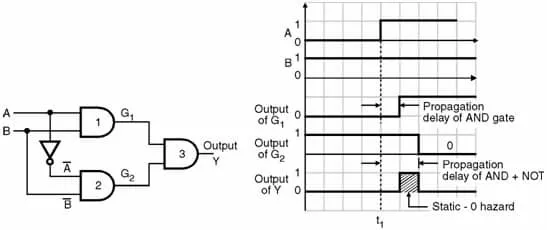Aka. Glitch. Momentary unwanted switching transient at a logic function’s output. Happens because of unequal propogation delays along different paths in a combinational circuit.
Static hazards
Section titled “Static hazards”Occurs when the output must remain unchanged but switches back and forth due to a change in input.
When a circuit is implemented as 2-level SOP or POS, the hazard can be detected using a K-map. There will be a glitch if any two adjacent minterms or maxterms are not covered by a single product or sum term. Glitches can be resolved by using redundunt gates.
Static-0 hazard
Section titled “Static-0 hazard”Occurs when output must stay at 0 but temporarily switches to a 1 due to a change in input. Would exist only if a variable and its component are connected to the same AND gate, either directly or via other gates.

Image by Electronics Tutorial website
Static-1 hazard
Section titled “Static-1 hazard”Occurs when output must stay at 1 but temporarily switches to a 0 due to a change in input.
In the example below, The 2 rectangles are enough to include all the HIGH outputs. Third one is added to avoid the static-1 hazard.
Dynamic hazards
Section titled “Dynamic hazards”Occurs when input changes, and output must change but temporarily flips between values. An unwanted change in output. Won’t occur in 2 level circuits. Identification and elimation is hard.
If there are 3 or more paths from an input or its complement to the output, the circuit has the potential for a dynamic hazard.

A slide by Jose Nelson Amaral
Elimination
Section titled “Elimination”For synchronous circuits: the clock signal can be tuned to eliminate hazards.
For asynchronous circuits: must use the methods mentioned above.